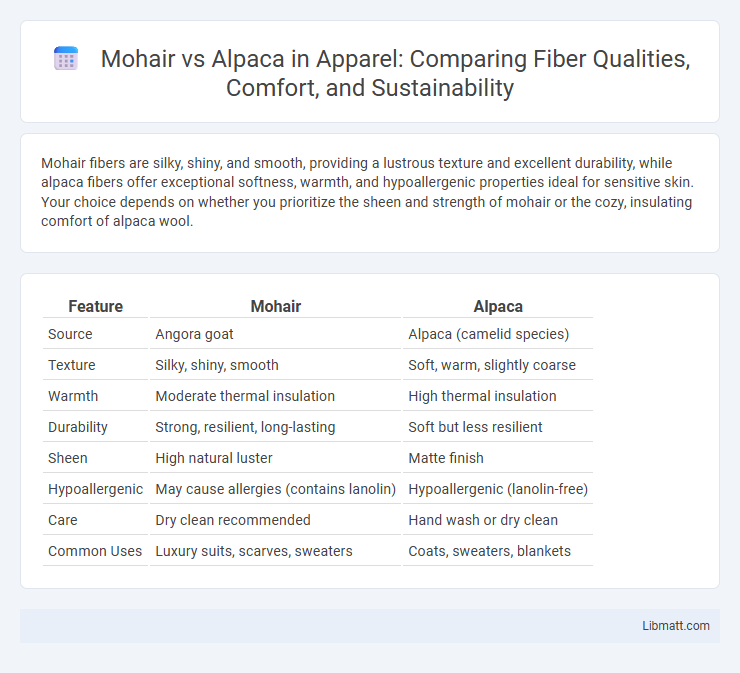Mohair fibers are silky, shiny, and smooth, providing a lustrous texture and excellent durability, while alpaca fibers offer exceptional softness, warmth, and hypoallergenic properties ideal for sensitive skin. Your choice depends on whether you prioritize the sheen and strength of mohair or the cozy, insulating comfort of alpaca wool.
Table of Comparison
| Feature | Mohair | Alpaca |
|---|---|---|
| Source | Angora goat | Alpaca (camelid species) |
| Texture | Silky, shiny, smooth | Soft, warm, slightly coarse |
| Warmth | Moderate thermal insulation | High thermal insulation |
| Durability | Strong, resilient, long-lasting | Soft but less resilient |
| Sheen | High natural luster | Matte finish |
| Hypoallergenic | May cause allergies (contains lanolin) | Hypoallergenic (lanolin-free) |
| Care | Dry clean recommended | Hand wash or dry clean |
| Common Uses | Luxury suits, scarves, sweaters | Coats, sweaters, blankets |
Introduction to Mohair and Alpaca
Mohair, derived from the Angora goat, is prized for its high luster, sheen, and durability, making it a preferred material in luxury textiles and fashion. Alpaca fiber, obtained from the South American alpaca, is known for its exceptional softness, warmth, and hypoallergenic properties, often used in high-end knitwear and blankets. Both fibers offer unique thermal insulation and moisture-wicking capabilities, yet differ significantly in texture, origin, and fiber structure, influencing their application in various textile products.
Origins and Production
Mohair originates from the Angora goat primarily raised in Turkey, South Africa, and the United States, with production centered on shearing twice annually to yield a silky, lustrous fiber. Alpaca fiber comes from the alpaca, native to the Andean regions of Peru, Bolivia, and Chile, where it is sheared once a year and valued for its softness and warmth. Understanding the origins and production of these fibers helps you choose between mohair's sheen and durability or alpaca's insulating qualities for your textile needs.
Fiber Characteristics
Mohair fibers, derived from the Angora goat, are known for their exceptional luster, strength, and elasticity, providing a silky smooth texture that is lightweight yet durable. Alpaca fibers, sourced from the South American alpaca, offer remarkable softness, warmth, and hypoallergenic qualities due to their fine diameter and lack of lanolin. Your choice between mohair and alpaca will depend on whether you prioritize sheen and resilience or softness and insulation in your textile projects.
Softness and Texture Comparison
Mohair fibers, sourced from Angora goats, exhibit a silky, lustrous texture with a smooth surface that creates a sleek and shiny appearance. Alpaca fibers, derived from alpacas, offer a dense, matte finish with a softer, warmer, and more cushioned feel due to their hollow core structure. Your choice between mohair and alpaca depends on whether you prioritize the smooth silkiness and sheen of mohair or the plush softness and thermal insulation provided by alpaca fibers.
Warmth and Insulation
Mohair fibers provide excellent warmth and insulation due to their hollow core structure, which traps heat effectively while remaining lightweight and breathable. Alpaca wool offers superior thermal insulation with natural crimps that create air pockets, enhancing temperature regulation and moisture-wicking properties. Both fibers excel in warmth, but alpaca typically surpasses mohair in insulating performance, making it ideal for colder climates.
Durability and Longevity
Mohair fibers, derived from Angora goats, exhibit exceptional durability due to their smooth, resilient structure and high tensile strength, making garments long-lasting and resistant to wear and tear. Alpaca fibers, sourced from South American alpacas, are also durable but tend to be softer and less elastic, which may reduce their longevity when subjected to frequent abrasion. Both fibers offer longevity, but mohair's tougher composition generally provides superior resistance to pilling and damage over time.
Hypoallergenic Properties
Mohair is made from the hair of the Angora goat and tends to contain lanolin, which can trigger allergic reactions in sensitive individuals, making it less hypoallergenic than alpaca. Alpaca fiber naturally lacks lanolin and has smooth protein structures, reducing the risk of irritation and making it highly suitable for people with allergies or sensitive skin. Both fibers provide softness, but alpaca's hypoallergenic properties make it a preferred choice for hypoallergenic textile products.
Sustainability and Ethical Considerations
Mohair and alpaca fibers differ significantly in sustainability and ethical considerations, with alpaca farming generally having a lower environmental impact due to the animals' efficient grazing habits and minimal need for water or chemicals. Mohair production involves Angora goats, which require regular shearing and can sometimes lead to animal welfare concerns if not managed ethically. You can support sustainable and ethical fashion by choosing alpaca products certified for humane treatment and environmentally responsible practices.
Popular Uses and Applications
Mohair is widely used in luxury fashion for its silky texture and sheen, commonly found in high-end suits, scarves, and upholstery, while alpaca fibers are favored for warm, lightweight garments such as sweaters, blankets, and hats due to their excellent insulation and softness. Your choice between mohair and alpaca may depend on the desired durability and feel, with mohair offering more luster and alpaca providing superior warmth and hypoallergenic properties. Both fibers are popular in knitwear and textile crafts, catering to different preferences in style and comfort.
Price and Value
Mohair typically commands a higher price due to its durability, luster, and versatility in luxury textiles, often making it a premium choice in the fashion industry. Alpaca fibers offer exceptional warmth and softness with a naturally hypoallergenic quality, providing significant value for cold-weather garments despite being generally less expensive than mohair. Consumers seeking a balance between cost and comfort often consider alpaca a more economical option without sacrificing quality.
Mohair vs alpaca Infographic

 libmatt.com
libmatt.com